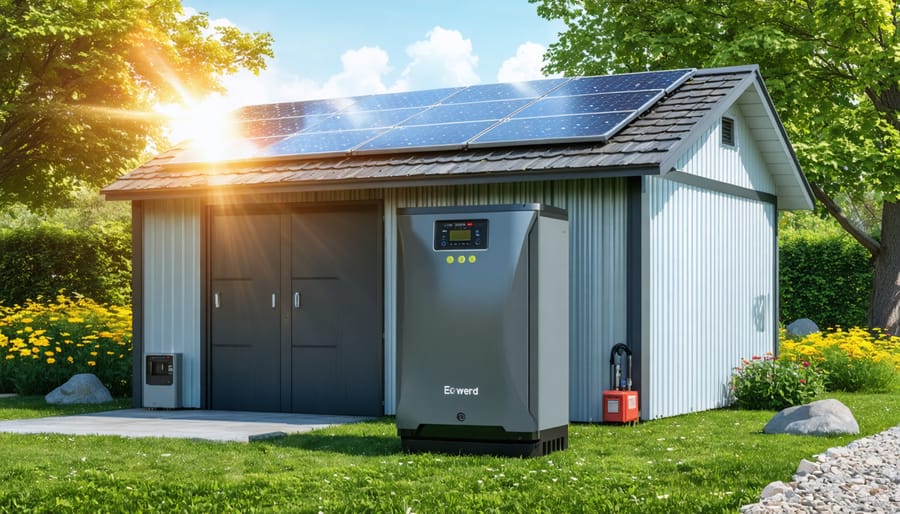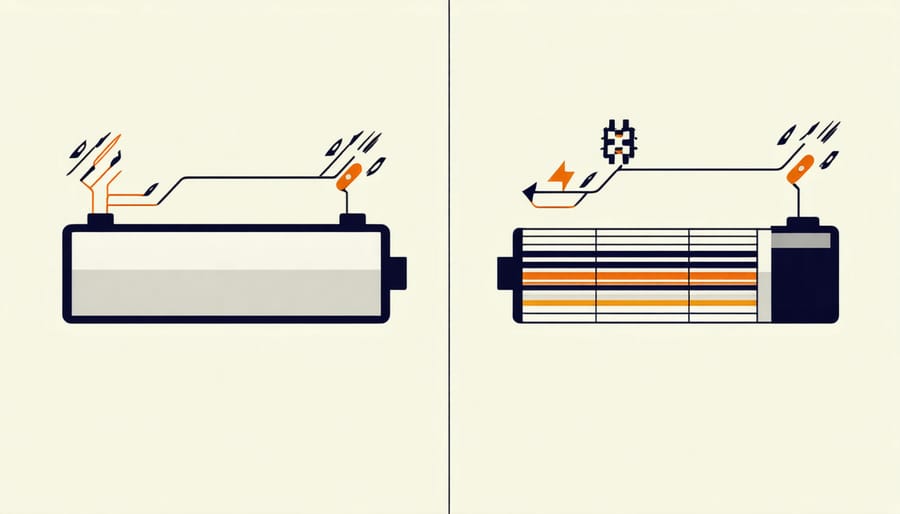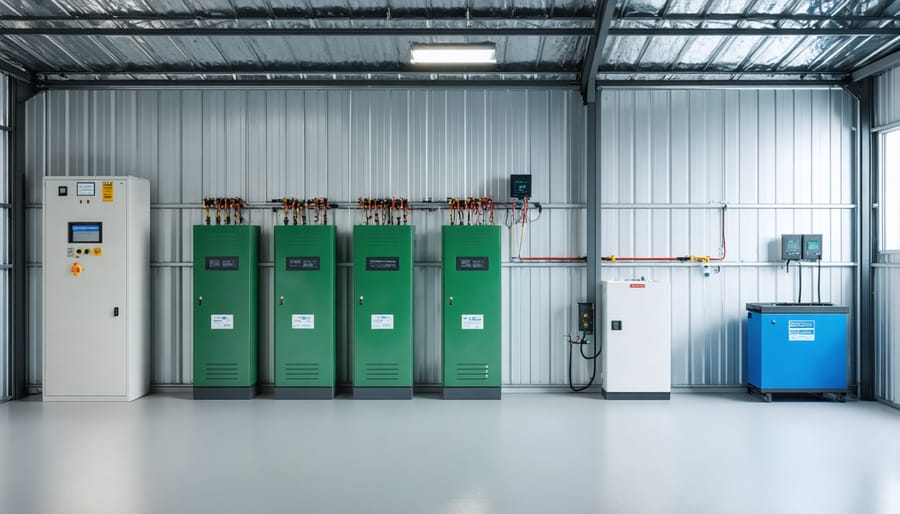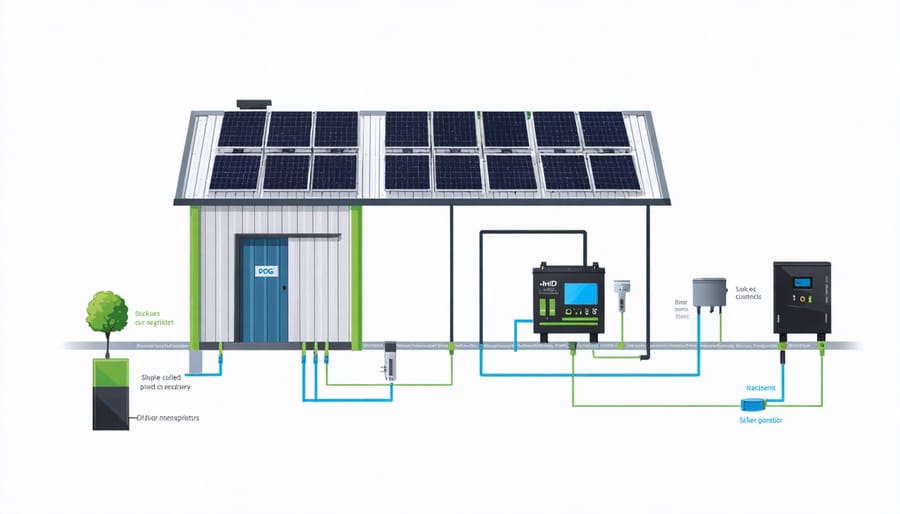How EV Batteries Transform Your Shed Into a Solar Power Powerhouse

Transform your home’s energy independence by repurposing electric vehicle (EV) batteries into powerful solar storage systems. These recycled powerhouses, often retaining 70-80% of their original capacity, offer an innovative and cost-effective solution for storing solar energy. While new solar batteries can cost upwards of $10,000, repurposed EV batteries provide similar functionality at a fraction of the price, typically ranging from $3,000 to $5,000 installed.
Homeowners nationwide are discovering how EV batteries, particularly from Nissan Leafs and Tesla vehicles, can be adapted to store excess solar power for nighttime use or backup during grid outages. These systems not only extend the life of valuable battery resources but also create a sustainable bridge between automotive and residential energy storage, potentially saving households thousands in annual energy costs.
Modern EV batteries, with their sophisticated battery management systems and high-density energy storage capabilities, have emerged as game-changers in the residential solar storage landscape, offering a practical pathway to energy independence without breaking the bank.
Why EV Batteries Make Perfect Sense for Shed Solar Storage
Capacity and Durability
EV batteries repurposed for solar storage offer impressive capacity advantages over traditional lead-acid batteries. A typical EV battery can store between 40-100 kWh of energy, enough to power an average home for several days, compared to standard deep-cycle batteries that usually provide just 1-3 kWh. Many homeowners find that a single EV battery pack can replace multiple traditional batteries, saving valuable space and reducing maintenance needs.
When it comes to durability, EV batteries truly shine. While traditional lead-acid batteries typically last 5-7 years, repurposed EV batteries can continue performing effectively for 10-15 years in stationary storage applications, even after their automotive life. They maintain about 70-80% of their original capacity when repurposed, which is more than adequate for home energy storage. Plus, these batteries can handle deeper discharge cycles without significant degradation, making them ideal for daily solar energy storage needs.

Cost-Effectiveness
When evaluating the financial aspects of using EV batteries for solar storage, it’s essential to consider both immediate and long-term costs. While the initial investment might seem substantial, a detailed solar power cost analysis reveals significant savings over time. Repurposed EV batteries typically cost 40-60% less than new solar storage batteries while offering comparable performance. A typical system can pay for itself within 5-7 years through reduced utility bills and potential energy credits.
The cost-effectiveness improves further when considering the extended lifespan of EV batteries, which can provide reliable storage for 10-15 years in less demanding stationary applications. Maintenance costs are minimal, requiring only basic monitoring and occasional professional checks. Many homeowners report monthly savings of $50-$150 on electricity bills, depending on their solar setup and energy consumption patterns. Additionally, some areas offer tax incentives and rebates for solar storage solutions, making the investment even more attractive.
Setting Up Your Shed’s EV Battery Storage System
Space Requirements and Ventilation
Proper placement of your EV battery storage system is crucial for both safety and efficiency. Choose a well-ventilated area that maintains a consistent temperature between 50-85°F (10-29°C). A dedicated space in your garage or utility room works well, but avoid placing the battery system in direct sunlight or near heat sources.
Ensure at least 12 inches of clearance around all sides of the battery for proper airflow. The installation area should be clean, dry, and protected from moisture. If installing in a basement, consider using a dehumidifier to control moisture levels.
Good ventilation is non-negotiable. While modern EV batteries are sealed systems, proper air circulation helps maintain optimal operating temperatures and disperses any unlikely but possible gas emissions. Install a ventilation fan if the space doesn’t have natural airflow. For enclosed spaces, consider adding a battery monitoring system that includes temperature and gas sensors for extra peace of mind.
The floor should be level and capable of supporting the significant weight of the battery system – typically 500-1000 pounds depending on capacity. A concrete floor or reinforced platform is ideal.


Essential Components and Connections
Setting up an EV battery for solar storage requires several key components working together seamlessly. At the heart of the system is the repurposed EV battery pack, which serves as your primary storage unit. You’ll need a compatible battery management system (BMS) to monitor and protect your battery’s health. This essential component prevents overcharging and ensures balanced cell performance.
The next crucial element is an inverter, which converts the DC power stored in your battery to usable AC power for your home appliances. Choose a hybrid inverter that can handle both solar input and battery storage for the most efficient solar installation setup. Don’t forget the charge controller, which regulates the power flow between your solar panels and the battery.
For safe installation, you’ll need proper cables and connectors rated for the system’s voltage and current. Include disconnect switches for both AC and DC sides, allowing you to safely isolate components when needed. A monitoring system helps you track performance and energy usage in real-time.
Essential safety equipment includes proper ventilation for the battery area, fire protection measures, and appropriate electrical enclosures. You’ll also want to install surge protection devices to guard against power spikes.
When connecting components, always follow manufacturer guidelines and local electrical codes. Start by mounting the battery in a clean, dry space, then install the BMS and inverter nearby to minimize cable runs. Connect the solar panels last, after thoroughly testing all other connections. Remember to label all wires and create a simple diagram of your setup for future reference.
Maintenance and Safety Considerations
Regular Maintenance Schedule
To keep your EV battery solar storage system running efficiently, establish a monthly maintenance routine. Start by visually inspecting all connections and cables for signs of wear, corrosion, or loose fittings. Check the battery temperature regularly using a thermal sensor, and ensure your ventilation system is working properly.
Every three months, clean any dust or debris from the battery housing and verify that the monitoring system displays accurate readings. Test the battery’s charge capacity and discharge rates to catch any performance issues early. If you notice any significant changes in charging patterns or efficiency, consult with a qualified technician.
Annually, schedule a professional inspection to assess the overall system health, including the battery management system (BMS) and safety features. Keep a maintenance log to track performance trends and any issues that arise. This helps identify patterns and predict potential problems before they become serious.
Remember to check your manufacturer’s specific maintenance guidelines, as requirements may vary between different battery models and systems. Regular maintenance not only extends your battery’s life but also ensures optimal performance for your solar storage setup.
Safety Protocols
When working with EV batteries for solar storage, following proper electrical safety precautions is absolutely essential. Always ensure your battery system is installed in a well-ventilated area away from moisture and extreme temperatures. Install smoke detectors and fire extinguishers rated for electrical fires nearby, and keep a clear access path to your battery setup.
Regular maintenance checks are crucial – inspect cables monthly for signs of wear, ensure all connections remain tight, and monitor the battery temperature. Consider installing a battery management system (BMS) to prevent overcharging and maintain optimal performance. Keep children and pets away from the storage area by installing proper barriers or locks.
Never attempt to modify or repair the battery system without proper knowledge or certification. In case of unusual sounds, smells, or visible damage, disconnect the system safely and contact a qualified technician immediately. Keep emergency contact numbers, including your electrician and fire department, posted near the installation area for quick reference.
Remember to document all safety procedures and share them with family members so everyone knows how to respond in case of an emergency.
Real-World Applications
Let’s explore how homeowners are successfully using EV batteries for solar storage in real-world settings. Sarah Thompson, a homeowner in Colorado, converted a Nissan Leaf battery to power her 800-square-foot workshop. The system provides reliable backup power during frequent winter outages while storing excess solar energy from her rooftop array.
In California, the Martinez family installed a repurposed Tesla Model S battery pack in their garden shed, connecting it to their existing solar system. This setup powers their home during evening hours and maintains their pool equipment, resulting in a 70% reduction in their monthly utility bills.
DIY enthusiast Mike Chen created a modular system using multiple Chevrolet Volt batteries, allowing him to expand storage capacity as needed. His setup powers his home office, workshop tools, and outdoor lighting, with enough capacity to run essential appliances during grid outages.
Community projects have also embraced this technology. The Green Valley Community Center retrofitted their maintenance shed with four repurposed EV batteries, creating a micro-grid that powers their greenhouse operations and provides emergency backup for their community center.
These success stories demonstrate the versatility of EV batteries in solar storage applications. Whether powering workshops, maintaining home operations, or supporting community initiatives, these systems offer reliable, sustainable energy solutions. The key to success lies in proper planning, professional installation when needed, and regular maintenance to ensure optimal performance and longevity.
Repurposing EV batteries for solar storage represents an innovative and cost-effective solution for homeowners looking to maximize their solar energy investment. By implementing this storage solution, you can significantly reduce your energy bills while contributing to environmental sustainability. The combination of durability, high capacity, and increasingly affordable prices makes EV batteries an attractive option for residential solar systems.
Remember to work with certified professionals for installation and always prioritize safety in your setup. While the initial investment might seem substantial, the long-term benefits of energy independence and reduced utility costs make it worthwhile. Many homeowners report satisfaction with their EV battery storage systems, noting improved reliability during power outages and better overall energy management.
As solar technology continues to advance and more EVs reach the end of their automotive life, we can expect even more accessible and efficient storage solutions. Whether you’re just starting your solar journey or looking to upgrade your existing system, EV batteries offer a practical and sustainable path forward. Take the first step today by consulting with local solar experts to explore the best options for your home.

